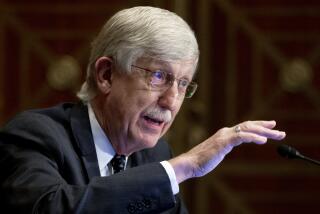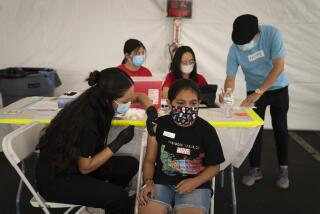U.S. Launches Ad Campaign Against AIDS
WASHINGTON — The federal government Thursday unveiled a $1.5-million AIDS education campaign aimed at women, teen-agers and residents of rural areas--people who “mistakenly believe that the AIDS epidemic will not affect them,” said Louis W. Sullivan, secretary of Health and Human Welfare.
While the estimated 1 million Americans infected with the human immunodeficiency virus continue to be predominantly gay men and intravenous drug users, Sullivan said, “The epidemic is spreading most rapidly today among heterosexuals, among teens and young adults and in areas outside of our big cities.”
At the heart of the new campaign are messages in fresh brochures, posters and public service announcements being distributed nationwide.
AIDS advocacy groups criticized the campaign material as too vague, however.
“We need an AIDS education campaign that teaches sexually active young people how to protect themselves from HIV,” said Teri Lewis, coordinator of the AIDS & Adolescents Network of New York. She gave this example as an explicit message she said is needed: “If you are having sex, use a condom.”
The government’s public service announcements feature the voices--but not the faces--of three people who have acquired immune deficiency syndrome, or AIDS. Each warns against complacency, but no one speaks of how the virus can be transmitted or how to guard against getting it.
The latest campaign is one aspect of a $300-million program for AIDS prevention and control, said Dr. James O. Mason, assistant secretary of Health and Human Services. The department’s Centers for Disease Control has other grant programs that funnel money to states, cities and localities, to allow them to tailor more specific and, in some cases, explicit messages to narrower audiences, added Dr. James W. Curran of the Atlanta-based CDC.
Mason said that the latest effort was inspired in part by 1991 poll data that showed an “unsettling” decline in the number of people expressing “personal concern” about the deadly virus--from 43% in 1988 to 24% by last year.
Recent government figures show that the number of new AIDS cases in metropolitan areas rose less than 5% last year, and rose at three times that rate in rural areas.
Rates among teen-agers have been rising virtually every year for a decade, with about 135 cases reported during 1991.
More to Read
Sign up for Essential California
The most important California stories and recommendations in your inbox every morning.
You may occasionally receive promotional content from the Los Angeles Times.










